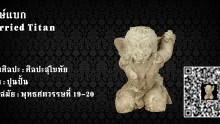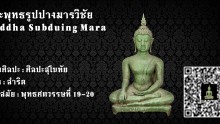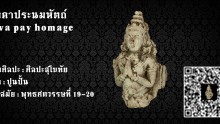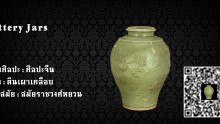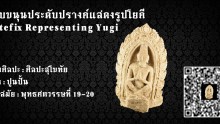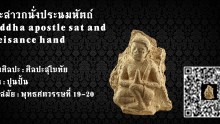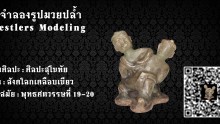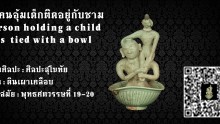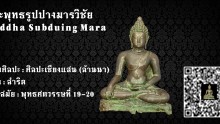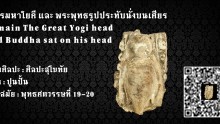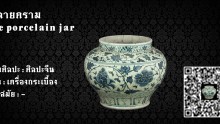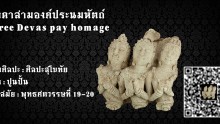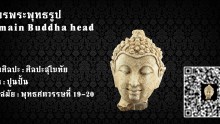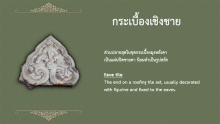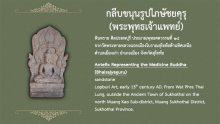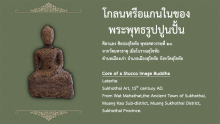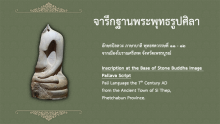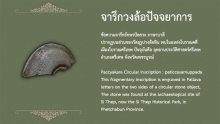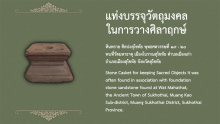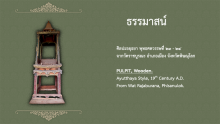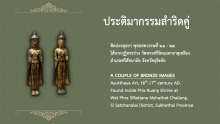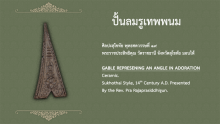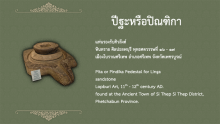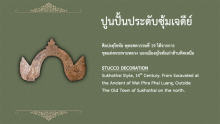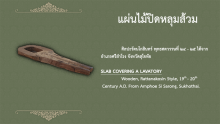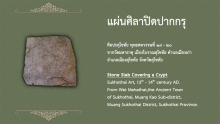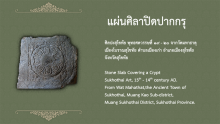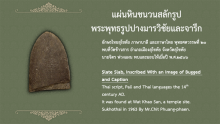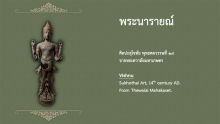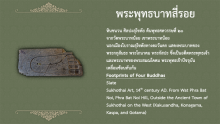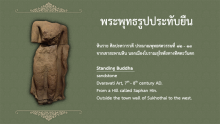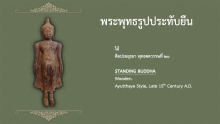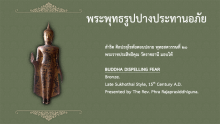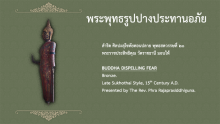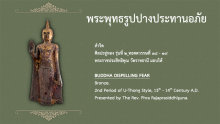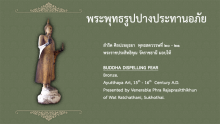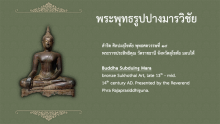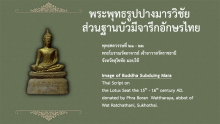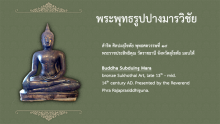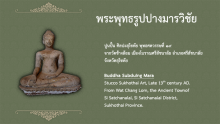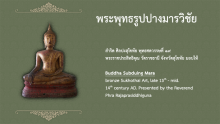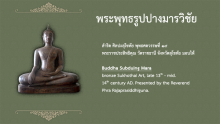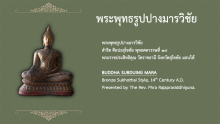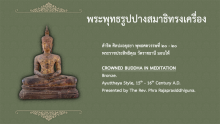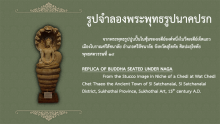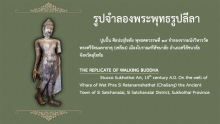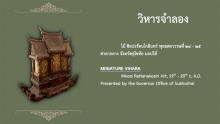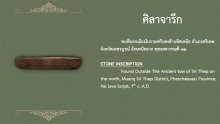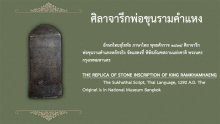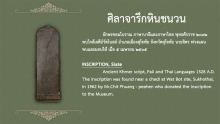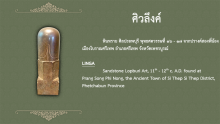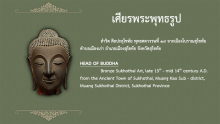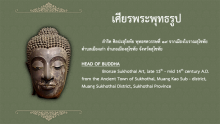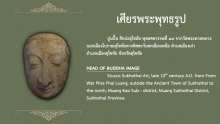การจัดแสดงในพิพิธภัณฑสถานแห่งชาติ รามคำแหง
ปัจจุบันพิพิธภัณฑสถานแห่งชาติ รามคำแหง มีอาคารจัดแสดงนิทรรศการ จำนวน 3 หลัง ประกอบด้วย
1. อาคารพิพิธภัณฑสถานแห่งชาติ รามคำแหง
2. อาคารอนุสรณ์ลายสือไท
3. อาคารปูนปั้นประติมาคาร
นอกจากนั้น บริเวณกลางแจ้งยังจัดแสดงโบราณวัตถุขนาดใหญ่ โบราณสถานที่เหลือเพียงส่วนฐานที่ได้รับการขุดแต่งและบูรณะเมื่อปีพุทธศักราช 2544 ซึ่งได้พบพระธาตุและสิ่งของมีค่าเป็นจำนวนมากบรรจุอยู่ภายในเครื่องสังคโลกและเครื่องถ้วยจีน อีกทั้งยังมีการจำลองเตาเผาเครื่องสังคโลก แสดงให้เห็นรูปแบบและกรรมวิธีการผลิตเครื่องสังคโลกสุโขทัย ฯลฯ
การจัดแสดงภายในอาคารอนุสรณ์ลายสือไท
อาคารอนุสรณ์ลายสือไท จัดแสดงนิทรรศการภาพ “สุโขไท – สุโขทัย อดีตและปัจจุบัน” โดยแสดงเรื่องราวภาพรวมของจังหวัดสุโขทัยในปัจจุบัน อาทิ ที่ตั้ง ภูมิประเทศ ขอบเขตการปกครอง สภาพภูมิอากาศ ทรัพยากรธรรมชาติ แหล่งท่องเที่ยว และความหลากหลายทางวัฒนธรรมของชาวสุโขทัย
ส่วนสุโขทัยในอดีต เป็นการให้ข้อมูลถึงการพัฒนาบริเวณเมืองเก่าสุโขทัยแต่ครั้งต้นกรุงรัตนโกสินทร์ การฟื้นฟูบูรณะโบราณสถานในเขตอุทยานประวัติศาสตร์สุโขทัย กระทั่งได้รับการประกาศให้เป็นแหล่งมรดกโลกทางวัฒนธรรมร่วมกับอุทยานประวัติศาสตร์ศรีสัชนาลัย และอุทยานประวัติศาสตร์กำแพงเพชร ในปีพุทธศักราช 2534
การจัดแสดงภายในอาคารพิพิธภัณฑสถานแห่งชาติ รามคำแหง ประกอบด้วยหัวเรื่องหลักดังนี้
1. โบราณวัตถุชิ้นเยี่ยมของพิพิธภัณฑ์
2. สังเขปประวัติการณ์การสร้างสรรค์สุโขทัย
3. จุดเริ่มแห่งวัฒนธรรมสัมพันธ์ในภูมิภาค กลองมโหระทึก ในจีนใต้และเอเชียตะวันออกเฉียงใต้
4. ฮินดูปฏิมาแห่งนครรัฐโบราณ
5. พระพุทธปฏิมาแห่งนครรัฐโบราณทวารวดี
6. จากชุมชนชาวป่ามาสู่การตั้งถิ่นฐานบ้านเมือง
7. ประติมากรรมปูนปั้น
8 ฮินดูปฏิมาในสุโขทัย
9. พระพุทธปฏิมาในสุโขทัย
10. ลายสือไท และวิวัฒนาการของตัวอักษรที่ปรากฏในประเทศไทย
11. อุโมงค์นิมิตวัดศรีชุม
12 เครื่องสังคโลก
13. พระธาตุที่พบจากการขุดแต่งโบราณสถานภายในพิพิธภัณฑสถานแห่งชาติ รามคำแหง
14. พุทธศิลป์ในประเทศไทย
15. พระพิมพ์สุโขทัย
จุดเริ่มแห่งวัฒนธรรมสัมพันธ์ในภูมิภาค กลองมโหระทึก ในจีนใต้และเอเชียตะวันออกเฉียงใต้
กลองมโหระทึกสำริดที่พบแพร่กระจายในแหล่งโบราณคดีในจีนใต้ (มณฑลยูนาน มณฑลกวางสี) เอเชียตะวันออก เฉียงใต้ ทั้งส่วนที่เป็นแผ่นดินใหญ่ คาบสมุทรมลายู และเกาะต่างๆในทะเลจีนใต้ เป็นหลักฐานแสดงถึงความสัมพันธ์กับวัฒนธรรมดองซอน ซึ่งมีแหล่งกำเนิดและเจริญรุ่งเรืองขึ้นบริเวณลุ่มแม่น้ำแดงในประเทศเวียดนาม และบริเวณจีนใต้เมื่อประมาณ 2,100 ปีมาแล้ว หรือในช่วงปลายวัฒนธรรมสำริด อิทธิพลของวัฒนธรรมทางวัตถุแบบดองซอนแพร่ไปตามเส้นทางการติดต่อค้าขายในภูมิภาคนี้สืบเนื่องต่อมาอีกนับศตวรรษ
การแพร่กระจายของกลองมโหระทึกรูปลักษณ์ดังกล่าว ซึ่งเข้ามาสู่ชุมชนต่างๆในเอเชียตะวันออกเฉียงใต้ มิได้เป็นเพียงเครื่องแสดงว่ามีการติดต่อค้าขาย “สินค้าสูงค่า” กันเท่านั้น แต่ยังเป็นสิ่งซึ่งแสดงถึงการรับคตินิยมประเพณีพิธีกรรมอันสัมพันธ์กับการใช้กลองมโหระทึกของชุมชนเหล่านี้ด้วย
สำหรับในประเทศไทย พบกลองมโหระทึกสำริดทั่วทุกภาค ซึ่งในเขตภาคเหนือตอนล่างได้พบกลองมโหระทึกสำริดแพร่กระจายในจังหวัดตาก สุโขทัย และอุตรดิตถ์
กลองมโหระทึก เป็นกลองที่หล่อขึ้นจากสำริด ซึ่งเป็นโลหะผสมระหว่างทองแดง ดีบุกและตะกั่ว มีลักษณะเป็นรูปทรง กระบอก บริเวณหน้ากลองมีการตกแต่งลวดลายประดับ เช่น ลายพระอาทิตย์ เรือ นกน้ำชนิดต่างๆ เป็นต้นว่า นกกระเรียน นกยาง นกยางทะเล สัตว์ครึ่งบกครึ่งน้ำ เช่น กบ และ หอย ลวดลายบนกลองมโหระทึกเหล่านี้มีความสัมพันธ์กับพิธีกรรมต่างๆ เพื่อความอุดมสมบูรณ์ พิธีขอฝน และพิธีกรรมเกี่ยวกับชีวิตและความตาย เป็นต้น
ชุมชนก่อนประวัติศาสตร์ในสุโขทัย จากหลักฐานทางโบราณคดีที่พบจากแหล่งโบราณคดีหลายแห่งในจังหวัดสุโขทัยและจังหวัดใกล้เคียง พบว่ามีการตั้งถิ่นฐานของผู้คนในบริเวณนี้มาตั้งแต่สมัยก่อนประวัติศาสตร์เมื่อประมาณ 3,000 ปีมาแล้ว โดยได้พบเครื่องมือหินจากแหล่งโบราณคดีเขาเขนเขากา อำเภอนครไทย จังหวัดพิษณุโลก เขากะล่อน
อำเภอขาณุวรลักษณ์บุรี จังหวัดกำแพงเพชร โครงกระดูกมนุษย์โบราณและเครื่องมือหิน ซึ่งสันนิษฐานว่าเป็นเคียวหินที่ใช้สำหรับการเกษตรกรรมจากแหล่งโบราณคดีบ้านบึงหญ้า อำเภอคีรีมาศ และชุมชนที่มีการถลุงโลหะที่แหล่งโบราณคดีบ้านวังหาด อำเภอบ้านด่านลานหอย จังหวัดสุโขทัย
กลุ่มคนที่เคยอาศัยอยู่บริเวณนี้อาจอยู่ต่อเนื่องกันและตั้งเป็นบ้านเมืองขึ้นในเวลาต่อมาจนกระทั่งประมาณพุทธศตวรรษที่ 12 เป็นต้นมา จึงได้มีการติดต่อกับดินแดนอื่นแถบบริเวณภาคกลางและภาคตะวันออกเฉียงเหนือที่ปรากฏมีวัฒนธรรมแบบทวารวดี โดยได้พบหลักฐานโบราณวัตถุที่มีลักษณะคล้ายคลึงกับโบราณวัตถุในวัฒนธรรมทวารวดี ได้แก่ ลูกปัด เหรียญเงินรูปพระอาทิตย์ จากแหล่งต่างๆในพื้นที่ตลอดจนการขุดค้นทางโบราณคดีที่วัดชมชื่น เขตอำเภอศรีสัชนาลัย จังหวัดสุโขทัย ที่พบโครงกระดูกมนุษย์อยู่ร่วมกับโบราณวัตถุในวัฒนธรรมทวารวดี
หลักฐาน ดัง กล่าวแสดงให้เห็นว่าบริเวณนี้เป็นแหล่งที่มีการอยู่อาศัยอย่างต่อเนื่องตั้งแต่สมัยก่อนประวัติศาสตร์สู่สมัยที่วัฒนธรรมแบบทวารวดีแพร่กระจายทั่วทุกภาคของประเทศไทย
พระพุทธปฏิมาแห่งนครรัฐโบราณและรูปเคารพในศิลปกรรมทวารวดี
พระพุทธศาสนาแพร่เข้าสู่ประเทศไทยเมื่อประมาณพุทธศตวรรษที่ 7-9 และต่อมาเมื่อประมาณพุทธศตวรรษที่ 11-12 พระพุทธศาสนาเจริญรุ่งเรืองอยู่ในบริเวณพื้นที่ภาคกลางของประเทศ โดยเฉพาะอย่างยิ่งในบริเวณที่ปรากฏนามในหลักฐานลายลักษณ์อักษรภาษาจีนและภาษาสันสกฤตว่า “ทวารวดี”
ปัจจุบันคำว่า “ทวารวดี” เป็นชื่อที่ใช้เรียกรูปแบบศิลปกรรมอย่างหนึ่ง ซึ่งเจริญรุ่งเรืองระหว่างพุทธศตวรรษที่ 11-16 และปรากฏอยู่ทั่วไปในดินแดนที่เป็นประเทศไทยในปัจจุบัน ในช่วงพุทธศตวรรษดังกล่าว ปรากฏการสร้างพุทธสถานที่เป็นสถูปเจดีย์ประดับปูนปั้นหลากหลายรูปทรงและขนาดในหลายแห่ง ตลอดจนการสร้างรูปเคารพและพระพุทธรูปด้วยวัสดุต่างๆ
จากหลักฐานศิลาจารึกภาษาบาลีที่พบในแหล่งทวารวดีต่างๆทำให้ทราบว่าวัฒนธรรมทางศาสนาของทวารวดี นับถือพระพุทธศาสนาฝ่ายเถรวาทหรือพระพุทธศาสนาภาษาบาลีเป็นสำคัญ อย่างไรก็ดี การพบรูปพระโพธิสัตว์ต่างๆ แสดงให้เห็นว่ามีการยอมรับนับถือพระพุทธศาสนาฝ่ายมหายานด้วยเช่นกัน ส่วนรูปเคารพในศาสนาฮินดูก็พบบ้าง เช่น รูปพระวิษณุ เป็นต้น
ศิลปกรรมทวารวดีพัฒนามาจากรูปแบบศิลปกรรมของอินเดียโดยเฉพาะศิลปกรรมแบบคุปตะและแบบหลังคุปตะจากภาคกลางและภาคตะวันตกของอินเดีย รวมทั้งอิทธิพลศิลปกรรมแบบปาละจากภาคตะวันออกเฉียงเหนือของอินเดีย ซึ่งต่อมามีการผสมผสานกับความเป็นท้องถิ่นหรือพื้นเมืองมากขึ้นโดยในพุทธศตวรรษที่ 16 หรือช่วงปลายของวัฒนธรรมทวารวดี งานศิลปกรรมที่ปรากฏแสดงถึงอิทธิพลศิลปะแบบเขมรอย่างชัดเจน
รูปเคารพในศาสนาฮินดูที่สุโขทัย
การติดต่อแลกเปลี่ยนทางการค้าและวัฒนธรรมระหว่างอินเดียและเอเชียตะวันออกเฉียงใต้ เริ่มขึ้นเมื่อไม่น้อยกว่าพุทธศตวรรษที่ 5 ชุมชนในเอเชียตะวันออกเฉียงใต้ได้เลือกรับและปรับใช้วัฒนธรรมและเทคโนโลยีจากอินเดียบางอย่างเพื่อให้เหมาะสมกับวัฒนธรรมดั้งเดิม เป็นต้นว่า ศาสตร์แห่งการเขียนตัวอักษรซึ่งได้ต้นแบบมาจากอินเดียใต้ มีการใช้ภาษาสันสกฤตและภาษาบาลีทั้งในราชสำนักซึ่งเป็นศูนย์รวมแห่งอาณาจักร วัด เทวาลัย ซึ่งเป็นศูนย์รวมแห่งศาสนจักรอย่างแพร่หลาย การสร้างและนับถือรูปเคารพในเทวาลัยจึงดำเนินมาพร้อมๆกับการรับนับถือศาสนาฮินดู
ในดินแดนประเทศกัมพูชาสมัยโบราณซึ่งเป็นถิ่นกำเนิดของวัฒนธรรมเขมรนั้น มีการพัฒนาและแพร่ขยายวัฒนธรรมตามแบบฮินดูเป็นอันมากโดยเฉพาะอย่างยิ่งในช่วงการเรืองอำนาจของกัมพูชาศาสนาฮินดูได้แผ่เข้าสู่ดินแดนที่เป็นประเทศ ไทยปัจจุบันในช่วงเวลานั้นสุโขทัยได้รับและสืบทอดคตินิยมการสร้างและนับถือเทพเจ้าต่างๆตามศาสนาฮินดู โดยเฉพาะอย่างยิ่งเทพเจ้าสำคัญ 3 พระองค์ ได้แก่ พระพรหม พระศิวะ และพระวิษณุ
ศิลปกรรมแบบเขมรนับเป็นรูปแบบที่สำคัญต่อวิวัฒนาการของศิลปกรรมสุโขทัย รูปแบบศิลปกรรมเขมรได้รับการสืบทอดมาอย่างต่อเนื่อง ดังที่ได้พบกลุ่มประติมากรรมเทวรูปและเทวนารีจากศาลตาผาแดง ที่แสดงถึงลักษณะศิลปกรรมร่วมสมัยกับศิลปะเขมรแบบนครวัดและบายน
แม้ว่าในช่วงแรก ศิลปกรรมสุโขทัยจะได้รับอิทธิพลศิลปกรรมเขมรอยู่มาก แต่ต่อมาศิลปกรรมสุโขทัยได้พัฒนาขึ้นจากคตินิยมและสุนทรียภาพตามแบบไทย นำไปสู่การสร้างสรรค์ประติมากรรมรูปเคารพศาสนาฮินดูขึ้น ช่วงปลายพุทธศตวรรษที่ 19 ถึงต้นพุทธศตวรรษที่ 20 ซึ่งนับเป็นงานสร้างสรรค์ชิ้นเยี่ยม เป็นเอกลักษณ์ มีความประณีต และสมบูรณ์แบบ สะท้อนความเป็นเอกลักษณ์เฉพาะถิ่น แสดงถึงรูปแบบของศิลปกรรมสุโขทัยอย่างแท้จริง
การสร้างรูปเคารพในศาสนาฮินดูสัมพันธ์กับทศพิธราชธรรมของกษัตริย์สุโขทัยในการเป็นองค์อุปถัมภกลัทธิศาสนาทุกๆศาสนาในพระราชอาณาจักร เพื่อความมั่นคงแห่งพระราชอำนาจ พระองค์ได้รับการค้ำจุนตามขนบธรรมเนียมประเพณีและพิธีกรรมจากพราหมณ์ทั้งหลาย ด้วยเหตุนี้พราหมณ์ซึ่งเป็นผู้ประกอบพิธีกรรมในราชสำนัก จึงมีบทบาทสำคัญต่อการสืบทอดขนบประเพณีในการบูชาเทพเจ้าของศาสนาฮินดู รูปเทพเจ้าฮินดูที่เป็นประติมากรรมสำริดตามแบบสุโขทัยเหล่านี้ คงสร้างขึ้นตามพระบรมราชโองการเพื่อการประกอบพิธีกรรมที่เกี่ยวเนื่องกับกษัตริย์เป็นสำคัญ โดยปรากฏในศิลาจารึกวัดป่ามะม่วง (จารึกสุโขทัยหลักที่ 4) ที่กล่าวถึงพระมหาธรรมราชาลิไท โปรดให้หล่อเทวรูปพระอิศวรและพระวิษณุไว้ในหอเทวาลัยมหาเกษตรในป่ามะม่วง เมื่อปีฉลู มหาศักราช 1271 (พุทธศักราช 1893) เพื่อให้เหล่าพราหมณ์สักการะบูชา
พุทธศิลป์สุโขทัย
พระพุทธรูปสมัยสุโขทัยเป็นงานสร้างสรรค์อันเป็นเอกลักษณ์โดดเด่น สะท้อนความงามตามอุดมคติแห่งความสงบเรียบง่ายโดยมีพื้นฐานแนวคิดจากพระพุทธศาสนาแบบเถรวาท พระพุทธรูปสมัยสุโขทัย สามารถแบ่งตามลักษณะพุทธศิลป์ได้ 4 หมวด ได้แก่
1. พระพุทธรูปหมวดวัดตระกวน
2. พระพุทธรูปหมวดใหญ่
3. พระพุทธรูปหมวดพระพุทธชินราช
4. พระพุทธรูปหมวดกำแพงเพชร
1.พระพุทธรูปหมวดวัดตระกวน
พระพุทธรูปในหมวดนี้ จัดเป็นพระพุทธรูปที่สร้างรุ่นแรกๆของสุโขทัย มีอายุประมาณต้นพุทธศตวรรษที่ 19 มีพุทธลักษณะคล้ายพระพุทธรูปแบบล้านนารุ่นแรก โดยมีลักษณะพระพักตร์อวบอ้วน พระขนงโก่ง พระเนตรเหลือบต่ำ หลังพระเนตรอูม พระโอษฐ์อมยิ้ม พระหนุเป็นปม ทรงครองจีวรห่มเฉียง ชายสังฆาฏิสั้นเหนือพระถันปลายหยักเขี้ยวตะขาบ พระรัศมีพบทั้งรูปดอกบัวตูมและรูปเปลวเพลิง ซึ่งในครั้งแรกได้พบพระพุทธรูปลักษณะนี้จากการขุดแต่งที่วัดตระกวน ภายในอุทยานประวัติศาสตร์สุโขทัย จึงเรียกพระพุทธรูปอย่างนี้ว่า หมวดวัดตระกวน
2.พระพุทธรูปหมวดใหญ่
พระพุทธรูปหมวดใหญ่เป็นหมวดที่พบเป็นจำนวนมาก เป็นที่นิยมสร้างกันในสมัยสุโขทัย มีลักษณะสำคัญได้แก่ หากสร้างเป็นพระพุทธรูปประทับนั่งมักจะประทับนั่งขัดสมาธิราบบนฐานหน้ากระดานเรียบ พระพักตร์รูปไข่ พระขนงโก่ง พระเนตรเรียวยาวเหลือบต่ำ พระนาสิกโด่งปลายงุ้ม พระโอษฐ์อมยิ้มเล็กน้อย พระรัศมีรูปเปลวเพลิง พระอังสากว้าง บั้นพระองค์เล็ก ครองจีวรห่มเฉียง ชายสังฆาฏิยาวจรดพระนาภี ปลายหยักเขี้ยวตะขาบ นิ้วพระหัตถ์ยาวเรียวปลายไม่เสมอกัน สันนิษฐานว่าน่าจะสร้างขึ้นในช่วงที่งานศิลปกรรมสมัยสุโขทัยเจริญรุ่งเรืองสูงสุดคือสมัยพระมหาธรรมราชาลิไท ประมาณต้นพุทธศตวรรษที่ 20
3.พระพุทธรูปหมวดพระพุทธชินราช
พระพุทธรูปหมวดพระพุทธชินราชมีพุทธลักษณะทั่วไปคล้ายแบบหมวดใหญ่แต่มีข้อแตกต่างบางประการ ได้แก่
พระพักตร์ที่ค่อนข้างแป้น พระรัศมีรูปเปลวเพลิงยืดสูงขึ้น พระวรกายค่อนข้างอวบอ้วน นิ้วพระหัตถ์ทั้งสี่ยาวเสมอกัน พระพุทธรูปหมวดนี้น่าจะสร้างขึ้นในสมัยพระมหาธรรมราชาลิไทประมาณต้นพุทธศตวรรษที่ 20 ถือเป็นช่วงที่เทคนิคการหล่อสำริดมีพัฒนาการสูงสุดเพราะช่างสามารถหล่อพระพุทธรูปที่มีขนาดใหญ่ได้โดยพระพุทธรูปที่จัดอยู่ในหมวดนี้ที่สำคัญได้แก่ พระพุทธ ชินราช พระศรีศาสดา วัดพระศรีรัตนมหาธาตุ จังหวัดพิษณุโลก และพระศรีศากยมุนี วัดสุทัศน์เทพวราราม กรุงเทพมหานคร เป็นต้น
4.พระพุทธรูปหมวดกำแพงเพชร
พระพุทธรูปหมวดกำแพงเพชร เป็นพระพุทธรูปที่มีลักษณะแตกต่างไปจากหมวดอื่นๆพบเฉพาะที่เมืองกำแพงเพชรแต่ในปริมาณที่น้อยมาก มีพุทธลักษณะโดยรวมคล้ายหมวดใหญ่ แต่พระพักตร์ค่อนข้างเสี้ยว ช่วงพระนลาฏกว้าง พระหนุค่อนข้างแคบ ขมวดพระเกศาเล็ก พระรัศมีเป็นเปลวเพลิงสูง สร้างขึ้นในช่วงพุทธศตวรรษที่ 20
พระพุทธรูปลีลา
พระพุทธรูปในอิริยาบถกำลังก้าวเดิน เป็นงานพุทธศิลป์ที่นิยมสร้างในสมัยสุโขทัย การสร้างพระพุทธรูปลีลาลอยตัวในสมัยสุโขทัยอาจหมายถึงพุทธประวัติตอนหนึ่งของพระพุทธเจ้าเมื่อครั้งเสด็จลงจากสวรรค์ชั้นดาวดึงส์หลังจากทรงเทศนาโปรดพระพุทธมารดา โดยเปรียบเทียบได้กับประติมากรรมปูนปั้นประดับผนังมณฑปวัดตระพังทองหลางโบราณสถานนอก เมืองสุโขทัยด้านทิศตะวันออกซึ่งมีองค์ประกอบเล่าเรื่องโดยทำรูปพระพุทธเจ้าในอิริยาบทลีลายกพระหัตถ์ซ้ายขึ้นด้านหลังเป็นบันไดแก้ว มีพระอินทร์และพระพรหมขนาบข้างและหมู่เทวดาประกอบข้างหลัง
การจัดแสดงภายในอาคารประติมากรรมปูนปั้น
ประติมากรรมปูนปั้น นับเป็นผลงานศิลปะอย่างหนึ่งซึ่งสะท้อนฝีมือ ภูมิปัญญาสร้างสรรค์ของช่างสุโขทัย ดังปรากฎหลักฐานปูนปั้นสำหรับตกแต่งโบราณสถาน หรือการปั้นพระพุทธรูปขนาดใหญ่โดยมีโกลนหรือหุ่นที่สร้างจากศิลาแลงหรืออิฐ รูปแบบลวดลายที่ปรากฏในงานปูนปั้น โดยเฉพาะลักษณะเครื่องแต่งกาย เครื่องประดับ ลวดลายประดับตกแต่ง ล้วนสะท้อนถึงวิถีต่างๆในสมัยสุโขทัยได้เป็นอย่างดี
โดยทั่วไปแล้ววัสดุและเทคนิคพื้นฐานที่ใช้ในการสร้างงานปูนปั้นของช่างไทย ประกอบด้วยการผสมหินปูนกับทรายละเอียดเข้าด้วยกัน โดยมีข้าวห่อกล้วยใส่เติมลงไปเพื่อเป็นตัวประสาน หินปูนที่ใช้ทำปูนปั้นต้องผ่านกระบวนการทำให้เป็นเนื้อปูนละเอียดอ่อนตัว สามารถปั้นขึ้นรูปได้ด้วยการหมัก-กวน-ตำ และเติมกาวที่ทำจากพืชหรือสัตว์ลงไปด้วย
ประติมากรรมนูนต่ำที่สร้างขึ้นจากการปั้นปูนที่ผ่านกระบวนการข้างต้น ขึ้นรูปตามแบบที่ต้องการได้โดยตรงหรืออาจใช้วิธีหล่อพิมพ์ก็ได้ แต่ถ้าต้องการทำชิ้นงานประติมากรรมขนาดใหญ่หรือปูนปั้นลอยตัวขนาดใหญ่ ต้องสร้างโกลนหรือหุ่นด้วยการแต่งศิลาแลงหรือก่ออิฐให้ได้รูปทรงหยาบๆตามที่ต้องการขึ้นมาก่อนเพื่อเป็นแกนหรือโครงให้ปูนยึด แล้วจึงปั้นปูนทับลงไปที่หุ่นจากนั้นจึงฉาบผิว ปั้นแปะ แต่งส่วนรายละเอียด และสำหรับประติมากรรมนูนสูงที่เป็นพระพุทธรูปติดอยู่กับศาสนสถานเมื่อก่ออิฐหรือศิลาแลงโกลนไว้แล้วอาจใช้ปูนปั้นพอกทับลงไปแล้วจึงตกแต่งรายละเอียดให้เป็นประติมากรรมปูนปั้นที่งดงามได้
รอยพระพุทธบาท
รอยพระพุทธบาท หมายถึง รอยเท้าของพระพุทธเจ้า หรือ รูปรอยที่เชื่อกันว่าเป็นรอยพิมพ์ฝ่าพระบาทของพระพุทธเจ้าที่ทรงเหยียบไว้บนพื้นโลกก่อนที่จะมีการสร้างรูปเคารพ หรือการสร้างพระพุทธรูปแทนองค์สมเด็จพระสัมมาสัมพุทธเจ้า โดยในประเทศอินเดียเมื่อประมาณพุทธศตวรรษที่ 5-6 ได้มีการสร้างสิ่งเคารพบูชาแทนองค์พระพุทธเจ้า เช่น รูปฉัตร รูปธรรมจักร และรูปพระพุทธบาท รอยพระพุทธบาท นับเป็นสิ่งที่นำมาเป็นเครื่องแสดงหรือประจักษ์พยานถึงการปรากฏพระองค์ของพระพุทธเจ้าในสถานที่ต่างๆ หรือให้ความหมายว่าพระธรรมคำสอนของพระพุทธองค์ได้เผยแผ่ไปสู่สถานที่นั้นๆแล้ว
คติการสร้างและการบูชารอยพระพุทธบาทในประเทศไทยมีมาแล้วไม่น้อยกว่าพุทธศตวรรษที่ 11-13 ในสมัยทวารวดีดังปรากฏหลักฐานรอยพระพุทธบาทคู่ที่เป็นรอยจำหลักเว้าลงไปในพื้นศิลาแลงที่โบราณสถานสระมรกต จังหวัดปราจีนบุรี
กระทั่งประมาณพุทธศตวรรษที่ 19 คติการสร้างรอยพระพุทธบาทปรากฏขึ้นอีกครั้งเนื่องจากอิทธิพลของพระพุทธศาสนาแบบลังกาวงศ์ ซึ่งระยะเวลานั้นมีพระเถระหลายรูปจากสุโขทัยและล้านนาได้เดินทางไปศึกษาพระพุทธศาสนาพระพุทธศาสนาถึงลังกาทวีปและเมืองพม่าที่พระพุทธศาสนาแบบลังกาวงศ์เจริญอยู่ และคงนำคติการสร้างและบูชารอยพระพุทธบาทซึ่งเป็นที่แพร่หลายในดินแดนเหล่านั้นมายังประเทศไทยด้วย
คติการจำลองรอยพระพุทธบาท กอปรด้วยเครื่องหมาย 108 ประการสำหรับเป็นที่สักการะบูชา ในสุโขทัยเริ่มขึ้นในสมัยพระมหาธรรมราชาลิไท ช่วงปลายพุทธศตวรรษที่ 19 โดยศิลาจารึกหลักที่ 8 (จารึกเขาสุมนกูฏ) กล่าวถึง การจำลองรอยพระพุทธบาทอันศักดิ์สิทธิ์บนเขาสุมนกูฏในเกาะลังกามาประดิษฐานไว้บนภูเขา 4 แห่งในราชอาณาจักรของพระองค์ เปรียบเสมือนสุโขทัยเป็นดินแดนที่พระพุทธเจ้าได้เคยเสด็จมาโปรด และทรงให้ความคุ้มครองตลอดไป ซึ่งภูเขา 2 แห่ง ในจำนวน 4 แห่งนั้นทรงขนานนามใหม่ว่า “สุมนกูฏ” เช่นเดียวกับภูเขาสำคัญในลังกาทวีป โดยภูเขาทั้ง 2 แห่ง นั้นน่าจะหมายถึงบริเวณเขาพระบาทน้อย และเขาพระบาทใหญ่ในเขตเมืองเก่าสุโขทัย
อุโมงค์นิมิตวัดศรีชุม
วัดศรีชุม โบราณสถานนอกเมืองเก่าสุโขทัยทางด้านทิศตะวันตกเฉียงเหนือ มีคูน้ำล้อมรอบ มีสิ่งก่อสร้างสำคัญคือมณฑปสี่เหลี่ยมจัตุรัสขนาดใหญ่ ภายในประดิษฐาน “พระอจนะ” พระพุทธรูปก่ออิฐถือปูนปางมารวิชัยขนาดใหญ่
ผนังมณฑปเบื้องขวาของพระพุทธรูปมีลักษณะเป็นช่องระหว่างผนัง มืดและแคบคล้ายอุโมงค์ ยาว 48.12 เมตร กว้าง 0.45 เมตร มีส่วนที่เจาะเป็นช่องระบายอากาศ แสงสว่างลอดผ่านเข้ามาได้เพียง 5 ช่อง หากเดินไปตามอุโมงค์ซึ่งมีขั้นบันไดไปเป็นลำดับจะสามารถขึ้นไปถึงด้านบนของมณฑปได้
บนเพดานเหนือปากทางเข้าสู่อุโมงค์ ปรากฏแผ่นหินชนวนสลักเป็นรูปดอกบัวบานและแผ่นหินสลักรูปรอยพระพุทธบาท ภายในอุโมงค์พบศิลาจารึกหินดินดาน เมื่อนำมาอ่านและแปลเนื้อความแล้ว เรียกต่อกันมาว่า ศิลาจารึกสุโขทัยหลักที่ ๒ หรือ ศิลาจารึกวัดศรีชุม
เมื่อเข้าไปภายในอุโมงค์ทั้งบนเพดาน ผนังทั้ง 2 ข้าง มีแผ่นหินชนวนจารเป็นภาพตอนสำคัญของ “ชาดก” เล่าเรื่องอดีตชาติของพระพุทธเจ้าก่อนการเสด็จมาอุบัติเป็นสมเด็จพระสัมมาสัมพุทธเจ้า
การสร้างภาพชาดกในสมัยสุโขทัยปรากฏหลักฐานในศิลาจารึกวัดศรีชุม ซี่งจารึกขึ้นประมาณพุทธศตวรรษที่ 19-20 ความว่า “พระเจดีย์สูงใหญ่ รอบนั้นฉลักหินห้าร้อยชาติติรเทศงามพิจิตรหนักหนาแก่กม” คำว่า “ห้าร้อยชาติ” หมายถึงพระโพธิสัตว์เสวยพระชาติในอดีต 500 ชาติภพ ภาพจารบนแผ่นหินชนวน ณ ที่นี้ ปรากฏภาพพร้อมคำอธิบายภาพย่อๆด้วยอักษรไทยสุโขทัย สันนิษฐานว่าเดิมมีอยู่ไม่น้อยกว่า 88 ภาพ ที่แปลความหมายได้ 51 ภาพ ส่วนแผ่นหินที่เหลือเสื่อมสภาพลบเลือน แปลความไม่ได้
พิพิธภัณฑสถานแห่งชาติ รามคำแหง ได้จำลองภาพจารชาดกบนแผ่นหินชนวนบางส่วน และนำจัดแสดงพร้อมคำอธิบายชาดกแต่ละตอนไว้ในส่วนจัดแสดง “อุโมงค์นิมิตวัดศรีชุม”
กำเนิดลายสือไท
เมื่อปีพุทธศักราช 1826 พ่อขุนรามคำแหงมหาราชแห่งกรุงสุโขทัยโปรดฯให้ประดิษฐ์อักษรไทยขึ้น การประดิษฐ์ตัวอักษรไทยนี้ได้ถือเอาอักษรโบราณของอินเดียมาเป็นต้นแบบแม้ว่ารูปอักษรไทยมีต้นเค้ามาจากรูปอักษรโบราณของอินเดีย (เช่น รูปอักษรปัลลวะ ในอินเดียตอนใต้) ซึ่งได้ผ่านการพัฒนามาเป็นอักษรขอม อักษรมอญ ที่มีใช้อยู่เดิมในพื้นถิ่น แต่อักษรไทยของพ่อขุนรามคำแหงก็ต่างออกไปอย่างชัดเจน อาทิ อักษรแต่ละตัวแยกกันเป็นอิสระมีลักษณะเฉพาะของแต่ละตัว การเขียนรูปสระวางไว้ในบรรทัดเดียวกับพยัญชนะ เช่น การเขียนสระ อิ อี อุ อู ในระบบเขมร/ระบบไทยปัจจุบัน เขียนไว้บนและล่างของพยัญชนะ แต่ระบบพ่อขุนรามคำแหงจะเขียนไว้ก่อนหรือหน้าพยัญชนะในบรรทัดเดียวกัน แล้วขยายขนาดสระให้โต ทัดเทียมกับตัวพยัญชนะ รวมทั้งมีการกำหนดสัญลักษณ์ที่เรียกว่า “วรรณยุกต์” เขียนกำกับไว้บนพยัญชนะ เพื่อให้ออกเสียงคำที่แตกต่างกัน
จากที่กล่าวมาข้างต้นถือเป็นลักษณะของความเป็นต้นตำรับและคุณลักษณะอันโดดเด่นในระบบการเขียนอักษรไทยแบบพ่อขุนรามคำแหง ในศิลาจารึกสุโขทัยหลักที่ 1 หรือศิลาจารึกพ่อขุนรามคำแหง ปรากฏคำว่า “ลายสือไท” ใช้ในการเรียกตัวอักษรไทยที่คิดขึ้นนี้ ซึ่งมีปรากฏอยู่รวม 61 ตัว มีพยัญชนะ 39 ตัว สระ 20 ตัว และวรรณยุกต์ 2 ตัว ลายสือไทของพ่อขุนรามคำแหงนับเป็นต้นแบบของอักษรไทยทั้งปวง ไม่ว่าจะเป็นอักษรไทยล้านนา ไทยอีสาน ไทยอยุธยา และไทยปัจจุบัน
ศิลาจารึกพ่อขุนรามคำแหง
ศิลาจารึกพ่อขุนรามคำแหง หรือ ศิลาจารึกสุโขทัยหลักที่ 1 ค้นพบโดยพระบาทสมเด็จพระจอมเกล้าเจ้าอยู่หัวรัชกาลที่ 4 ในปีพุทธศักราช 2376 ครั้งที่พระองค์ดำรงพระอิสริยยศเป็นสมเด็จพระเจ้าน้องยาเธอ เจ้าฟ้ามงกุฎฯ ขณะที่ทรงผนวชได้เสด็จจาริกธุดงค์ไปหัวเมืองทางเหนือของประเทศไทย เมื่อถึงเมืองสุโขทัยทรงพบศิลาจารึกพ่อขุนรามคำแหงที่เนินปราสาท เมืองเก่าสุโขทัย ทอดพระเนตรเห็นเป็น “โบราณวัตถุที่สำคัญ” จึงโปรดให้นำลงมาที่กรุงเทพมหานคร เมื่อปีพุทธศักราช 2376 พร้อมกับศิลาจารึกวัดป่ามะม่วง และพระแท่นมนังศิลาบาตร ปัจจุบันศิลาจารึกพ่อขุนรามคำแหง จัดแสดงที่พิพิธภัณฑสถานแห่งชาติ พระนคร กรุงเทพมหานคร
ศิลาจารึกสุโขทัยหลักนี้เป็นบันทึกเพื่อประกาศเรื่องราวในรัชสมัยของพ่อขุนรามคำแหงมหาราช กล่าวถึงสิ่งสำคัญควรค่าแก่การจดจำรำลึก ได้แก่
- การคิดสร้างสรรค์อักษรไทยขึ้นในปีพุทธศักราช 1826
- การประดิษฐานพระแท่นมนังษีลาบาตร ในปีพุทธศักราช 1835
- การปฏิบัติธรรม กระทำพุทธบูชา สักการะสิ่งศักดิ์สิทธิ์ของพระมหากษัตริย์และอาณาประชาราษฎร์
- การสร้างและประดิษฐานศิลาจารึกอีกหลายหลัก ซึ่งจารด้วยอักษรไทย ภาษาไทย แสดงถึงความสำเร็จในการรวบรวมชาติไทย
- การสรรเสริญพระเกียรติคุณและแสนยานุภาพอันเกรียงไกรของพ่อขุนรามคำแหง มีขอบเขตพระราชอาณาจักรเป็นประจักษ์พยาน
ศิลาจารึกพ่อขุนรามคำแหงได้รับการประกาศขึ้นทะเบียนให้เป็น “เอกสารมรดกความทรงจำโลก” โดยองค์การศึกษาวิทยาศาสตร์และวัฒนธรรมแห่งสหประชาชาติ (UNESCO) เมื่อวันที่ 16 ตุลาคม 2546
สังคโลกสุโขทัย
สังคโลก เป็นชื่อเรียกเครื่องปั้นดินเผาเนื้อแกร่งแบบโบราณที่ผลิตขึ้นในสุโขทัย เมื่อประมาณพุทธศตวรรษที่ 19-20 มีทั้งชนิดไม่เคลือบ และเคลือบสีต่างๆ เช่น สีน้ำตาล สีเขียวไข่กา สีขาว การตกแต่งลวดลายบนสังคโลก พบทั้งการขูดขีดให้เป็นลวดลาย การปั้นแปะ และการเขียนสีดำให้เป็นลวดลายโดยเคลือบน้ำเคลือบใสทับอีกครั้งหนึ่ง ซึ่งลวดลายที่พบมากได้แก่ ลายปลา ลายกงจักร ลายสังข์ และลายดอกไม้ก้านขด เป็นต้น
ผลิตภัณฑ์สังคโลก มีมากมายหลายรูปแบบ ขึ้นอยู่กับวัตถุประสงค์ในการใช้งาน เป็นต้นว่า
1. ใช้เป็นภาชนะใช้สอยในชีวิตประจำวัน เช่น จาน ชาม ถ้วย ขวด ไห ตลับ ประปุก ตะเกียง เป็นต้น
2. ใช้ในพิธีกรรมทางศาสนา เช่น คนโทที่มีรูปแบบพิเศษ รูปเคารพทางศาสนา ไหบรรจุอัฐิ และตุ๊กตาเสียกบาล เป็นต้น
3. สำหรับเป็นเครื่องประดับตกแต่งสถาปัตยกรรม ซึ่งพบทั้ง ช่อฟ้า หรือ ปั้นลม กระเบื้องมุงหลังคา กระเบื้องปูพื้น บราลี หางหงส์ ราวลูกกรง แปครอบ รูปโทวาริกที่ทำเป็นรูปยักษ์เฝ้าศาสนสถานและรูปมกรสำหรับตกแต่งราวบันได
4. ใช้เป็นของเล่น เช่น รูปตุ๊กตาผู้ชายอุ้มไก่ แม่อุ้มลูก รูปสัตว์ขนาดเล็ก เช่น ช้าง สุนัข ไก่ เต่า และรูปตุ๊กตามวยปล้ำ เป็นต้น
5. อื่นๆ ได้แก่ ท่อน้ำสำหรับการชลประทาน เป็นต้น
ช่วงพุทธศตวรรษที่ 20 เครื่องสังคโลกได้รับการพัฒนาให้มีคุณภาพดีขึ้น ทั้งเนื้อดิน น้ำเคลือบ รูปทรง ตลอดจนการตกแต่งลวดลาย สามารถส่งออกไปจำหน่ายทั้งภายในและภายนอกประเทศ โดยได้พบเครื่องสังคโลกสุโขทัยเป็นจำนวนมากในซากเรืออับปางบริเวณชายฝั่งอ่าวไทยและชายฝั่งทะเลตอนใต้ในลักษณะเป็นทั้งภาชนะใช้สอยในชีวิตประจำวันและเป็นสินค้า นอกจากนั้นยังได้พบเครื่องสังคโลกในแหล่งฝังศพของชุมชนโบราณในประเทศฟิลิปปินส์ แสดงถึงการแพร่กระจายของเครื่องสังคโลกยังต่างแดนได้เป็นอย่างดี
แหล่งผลิตเครื่องสังคโลกที่สำคัญในสุโขทัย
1. แหล่งเตาที่เมืองเก่าสุโขทัย กระจายอยู่ใกล้ริมน้ำแม่โจนทางทิศเหนือของวัดพระพายหลวง ลักษณะของเตาเผามี 2 รูปแบบ คือ แบบระบายความร้อนในแนวตั้ง และแบบระบายความร้อนในแนวนอน สังคโลกที่ผลิตขึ้นที่เมืองเก่า มีเนื้อดินที่ไม่ค่อยดีนัก จึงต้องมีการชุบน้ำดินเพื่อรองพื้นก่อนแล้วจึงเขียนลายสีดำ จากนั้นจึงเคลือบสีเขียวใสทับอีกชั้นหนึ่ง
2. แหล่งเตาที่เมืองศรีสัชนาลัย ได้พบเตาเผาเป็นจำนวนมากตั้งเรียงรายริมฝั่งแม่น้ำยม บริเวณบ้านป่ายางและบ้านเกาะน้อย ซึ่งเตาเผาที่บ้านป่ายาง มักผลิตเครื่องสังคโลกที่มึขนาดใหญ่และตกแต่งด้วยการเขียนลายดำ เช่น เครื่องประดับตกแต่งสถาปัตยกรรม ส่วนผลิตภัณฑ์จากแหล่งเตาบ้านเกาะน้อย ส่วนมากเป็นเครื่องสังคโลกคุณภาพดี พบทั้งชนิดเคลือบสีเขียวมะกอก สีเขียวไข่กา สีน้ำตาลดำ และเคลือบสีขาว เขียนลายสีน้ำตาล
ห้องพระธาตุ
ห้องพระธาตุ จัดแสดงโบราณวัตถุและสิ่งของมีค่าที่ได้จากการขุดแต่งบูรณะโบราณสถานสมัยสุโขทัยซึ่งตั้งอยู่ภายในพิพิธภัณฑสถานแห่งชาติ รามคำแหง
โบราณวัตถุที่สำคัญ ได้แก่ พระธาตุสีขาวขุ่น มีขนาดเท่าเม็ดทราย บรรจุภายในผอบทองคำภายในช่องกรุเจดีย์ทรายของโบราณสถานหมายเลข 1 โดยเชื่อว่าเป็นพระอัฐิธาตุของพระอรหันต์สาวกองค์ใดองค์หนึ่ง
โบราณวัตถุอื่นๆ ที่พบร่วมกับพระธาตุ ได้แก่ พระพิมพ์ เนื้อว่าน และชิน และมีพระพิมพ์บุทอง บุเงิน พระพิมพ์ไม้ พระพิมพ์ดินเผา แก้วผลึก แท่งแก้ว ลูกปัด แหวนทองคำหัวพลอย เป็นต้น
สิ่งของเหล่านี้บรรจุไว้เพื่อเป็นเครื่องน้อมระลึกถึงพระพุทธเจ้าหรือพระสงฆ์ ถวายเป็นพุทธบูชา และเป็นเครื่องสืบทอดพระพุทธศาสนา
ธรรมเนียมการสร้างพระมหาธาตุมีมาตั้งแต่ครั้งหลังพระพุทธเจ้าปรินิพพาน โดยกษัตริย์แคว้นต่างๆในชมพูทวีปได้รับส่วนแบ่งพระบรมสาริกธาตุเป็น 8 ส่วน นำไปสร้างบรรจุสถูปไว้ยังบ้านเมืองของตน เพื่อเป็นที่เคารพสักการะของมหาชนจำนวน 8 แห่ง
ต่อมาในราวพุทธศตวรรษที่ 3 พระเจ้าอโศกมหาราช จักรพรรดิผู้ครองมัธยมประเทศ ทรงเป็นเอกอัครศาสนูปถัมภกทรงรวบรวมพระบรมสารีริกธาตุแบ่งไปสร้างพระสถูปยังบ้านเมืองต่างๆ รวมถึงบ้านเมืองที่ทรงส่งสมณทูตไปเผยแผ่พระพุทธศาสนา กล่าวว่ามีการสร้างพระสถูปจำนวนถึง 84,000 องค์ ธรรมเนียมการสร้างพระสถูปบรรจุพระบรมสารีริกธาตุนี้ได้เผยแผ่มาพร้อมกับการรับนับถือพระพุทธศาสนาในดินแดนประเทศไทย โดยนับถือว่าพระบรมสารีริกธาตุเป็นปูชนียวัตถุสำคัญยิ่งกว่าวัตถุมงคลอื่น คติความเชื่อนี้ได้ปรากฏอยู่ในอาณาจักรสุโขทัยด้วย












